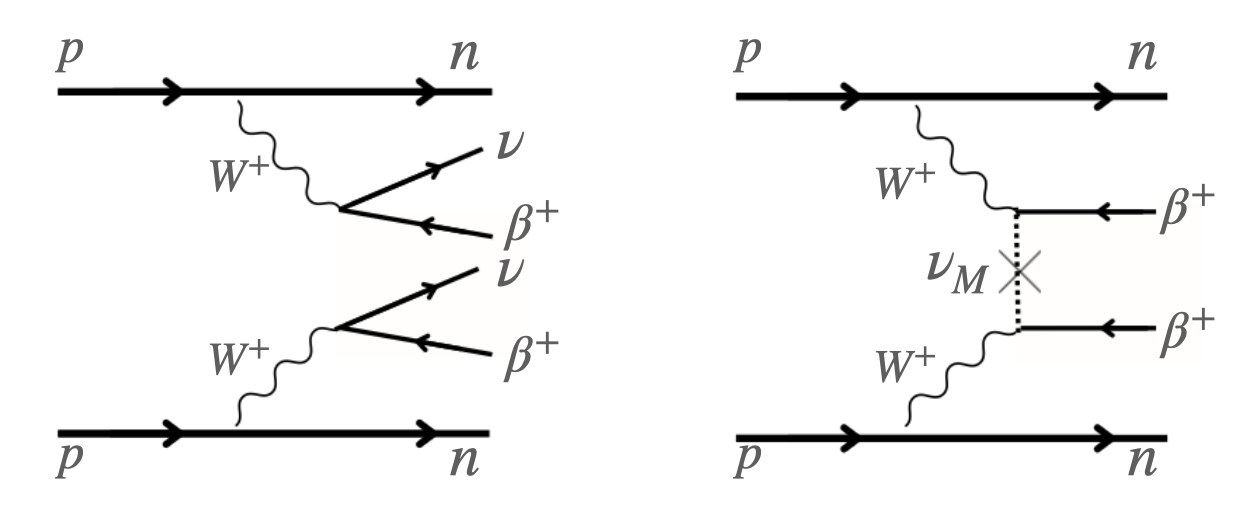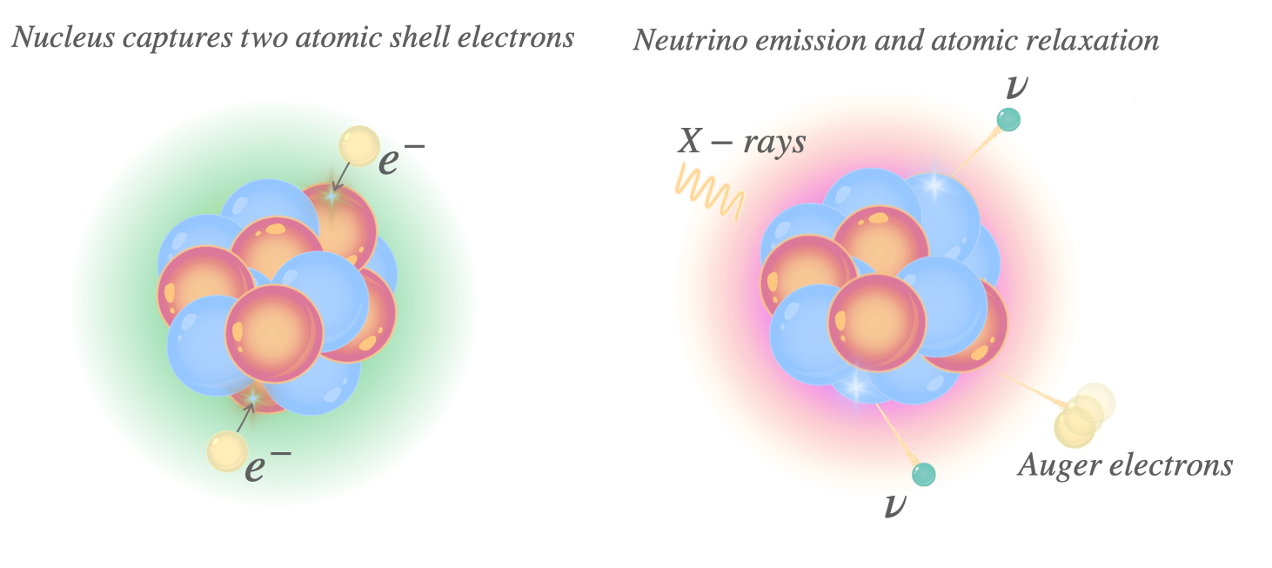 Search for Double Beta Plus Decays |



|
Double Beta DecayDouble beta decay is a rare type of radioactive decay where two neutrons are simultaneously transformed into two protons, or vice versa, within an atomic nucleus. This results in a change of the nuclear charge number by two units while the nucleon number remains unchanged. Similar to single beta decay, this process allows the atom to achieve a more stable proton-to-neutron ratio. As a result, the nucleus emits two beta particles, which are detectable as either electrons or positrons, along with two (anti)neutrinos. Unstable nuclei may undergo two-neutrino double beta decay (2νββ) when single beta decay is energetically forbidden or highly suppressed by angular momentum conservation. The extreme rarity of this decay is highlighted by the very long half-lives (from 1018 to 1024 years) of the nuclides that undergo this process. Consequently, observing double beta decay in a laboratory setting is exceptionally challenging, requiring highly enriched radionuclide sources and sophisticated instrumentation. Double beta decay, first predicted by Maria Goeppert-Mayer in 1935. The first indirect evidence of this phenomenon was reported in 1966 for tellurium in Japan and in 1967 for selenium in a collaboration between the MPIK Heidelberg and the State University of New York. Its direct observation was achieved only in 1987 when scientists Steven R. Elliott, Alan A. Hahn, and Michael K. Moe successfully detected it in a sample of selenium-82. Double beta decay can occur in different modes, depending on the particles emitted during the decay. There are two primary modes of interest:

In the realm of nuclear and particle physics, significant experimental and theoretical efforts have been dedicated to understanding the double electron emission mode, a process that increases the nuclear charge by two units. However, this is just one part of the story. There are other intriguing modes of double beta decay that decrease the nuclear charge number. These include double positron decay (2β+), positron-emitting electron capture (ECβ+), and double electron capture (2EC). While all three of these nuclear charge-decreasing two-neutrino double beta modes (2β+, ECβ+, and 2EC) are theoretically allowed within the framework of the Standard Model, only one—2ν2EC—has been experimentally observed so far. 
The exploration of double beta decay processes such as double positron decay (2β+), positron-emitting electron capture (ECβ+), and double electron capture (2EC) is a well-motivated pursuit, driven by both theoretical and experimental advancements. These studies are crucial for refining our nuclear structure models as they provide data that constrain theories and improve calculations of nuclear matrix elements (NMEs). Furthermore, the study of neutrinoless positron-emitting processes holds promise for insights into new physics beyond the Standard Model. The NuDoubt++ ExperimentNuDoubt++ Experiment OverviewThe NuDoubt++ experiment is focused on detecting the rare nuclear process of double beta plus decay, which involves the emission of two positrons. Measuring this decay is challenging due to its low probability, difficult-to-detect signatures, and the scarcity of suitable candidate nuclei. To address these challenges, we have developed an innovative detector concept that combines hybrid and opaque scintillation detector technologies with new light read-out techniques. This combination is particularly effective for identifying positrons. We anticipate that with just one tonne-week of exposure, our detector will be capable of discovering two-neutrino double beta plus decay modes. Furthermore, it has the potential to significantly improve the detection limits for neutrinoless double beta plus decays compared to current experiments. Introduction to Our ApproachThe search for neutrinoless double beta decay (0νββ) is crucial for understanding whether neutrinos are their own antiparticles (Majorana particles). Current experiments have set half-life limits for neutrinoless double beta minus decay (0ν2β-) isotopes around 1026 years. However, to explore the effective Majorana neutrino mass associated with normal neutrino mass ordering, these limits need to be extended by several orders of magnitude. Achieving this requires experiments with larger quantities of double beta decay isotopes (tens of tonnes), superior energy resolution to differentiate the signal from the background, and excellent methods to maintain a clean detection region. Our NuDoubt++ detector concept meets these demands, using innovating isotope-loaded liquid scintillator detectors. Our approach integrates hybrid scintillators, which measure the ratio of Cherenkov and scintillation signals, with opaque scintillators that provide detailed event topology. This combination greatly enhances background discrimination and allows for heavy isotope loading without significantly affecting the scintillation output or energy resolution. Double beta searches using hybrid and opaque scintillators have been suggested in the past, with significant theoretical and experimental advancements over the years. The NuDoubt++ PrototypeThe cylindrical detector prototype, measuring roughly 110 cm in both diameter and height, consists of approximately one metric tonne of hybrid-slow opaque scintillator. It is designed to test the hybrid and opaque particle discrimination capabilities, with OWL-fibres running parallel to the cylinder's symmetry axis and arranged in a triangular grid with a 1 cm pitch. Each fibre connects to SiPMs on both ends, enabling precise energy and spatial measurements. This design allows for the deployment of positron, gamma, and electron sources at its center to verify discrimination strategies. Monte Carlo simulations indicate effective containment and energy reconstruction capabilities for electron, positron, and gamma events. GoalsThis setup is well-suited for initial measurements of two-neutrino double weak decays such as 2ν2β+ and 2νECβ+, and for setting limits on the neutrinoless decays 0νECβ+ and 0ν2β+. The primary isotopes of interest are Kr-78, Xe-124, and Cd-106. The prototype aims to demonstrate the essential properties of the detector and provide valuable data to support theoretical models of neutrinoless double beta decay. If successful, the detection of 2νECβ+ and 2ν2β+ decays would represent the observation of the rarest standard model decay processes known. The prototype can be deployed in an underground facility for advanced decay mode searches, with potential enhancements in volume and isotope loading strategies for increased sensitivity. Expected PerformanceThe primary strategy for background rejection in neutrinoless decay searches is defining a small energy window, or region of interest (ROI), around the mono-energetic line from positrons. Achieving a small ROI requires excellent energy resolution. We propose a hybrid-slow opaque scintillator consisting of 88% linear alkylbenzene (LAB), 10% diisopropylnaphtalene (DIN), and 2% wax with diphenyloxazole (PPO) as a wavelength shifter. This scintillator achieves a light yield of 9000 photons/MeV, an attenuation length of 17 meters, and a scattering length of 2 millimeters. The slow scintillation emission, with primary and secondary decay-time constants of 13 ns and 26 ns respectively, delays the scintillation light, making the Cherenkov peak more distinct. The expected purity of Cherenkov light in the Cherenkov peak is 80%. Current opaque detector readout technology is expected to reach between 350 and 550 Photon Equivalences (PE) per MeV, with improvements possible through optimized wavelength-shifting light guides (OWL-fibers), potentially achieving more than 800 PE/MeV. More Details about the Detector ConceptThe ScintillatorHybrid ScintillatorHybrid scintillators use the ratio of Cherenkov and scintillation light to distinguish between particle types. Massive particles produce less Cherenkov light, while gamma rays produce minimal Cherenkov light due to Compton scattering. Positrons generate less Cherenkov light compared to electrons. There are two approaches:
In NuDoubt++, opacity is introduced to the slow hybrid scintillator, improving spatial resolution and particle identification. Opaque ScintillatorOpaque scintillators use Mie scattering to confine scintillation light, collected by wavelength-shifting fibers leading to SiPMs. This retains topological information, allowing differentiation based on energy deposition patterns. Electrons create single light blobs, gammas multiple, and positrons a mix. Opacity can be achieved by blending transparent scintillator with wax, which maintains high light yields. Annihilation gamma energy can be reconstructed from initial Compton-scatter vertices, allowing precise measurements and the potential to count annihilation gammas in double positron decay events. Combining Hybrid and Opaque ScintillatorsBy combining hybrid and opaque scintillator techniques, we aim to leverage the complementary background rejection capabilities of both. This combination allows for detailed event topology analysis, using a blob-dependent Cherenkov/Scintillation (C/S) ratio to identify primary vertices and distinguish between overlapping blobs of lower energy. This hybrid-opaque approach becomes feasible through advancements in extending opaque scintillator to various solvents, including those in the hybrid slow solvent scintillator. This medium allows for high levels of isotope loading, maintaining usability despite the typically negative impact on transparency in classic scintillators. Optimised WaveLength-shifting (OWL) FibresFor the NuDoubt++ experiment, we utilize Optimised Wavelength-shifting fibres (OWL-fibres) to enhance light collection efficiency. These fibres are designed with the wavelength-shifters (WLS) located on the outer surface, maximizing the probability of photon capture via total internal reflection. Polystyrene-based OWL-fibres can achieve a theoretical maximum trapping efficiency of up to 38%, capturing nearly four times more photons than conventional doped fibres with central emission points. Leveraging expertise from Wavelength-shifting Optical Modules (WOMs), the OWL-fibres demonstrate superior light collection, making them ideal for high-performance opaque scintillation detectors. Initial tests indicate competitive performance even with reduced attenuation lengths, with ongoing efforts to further reduce self-absorption losses using advanced WLS materials and quantum dots. Stay tuned for more updates and detailed results from our ongoing research and development efforts in the NuDoubt++ experiment! |